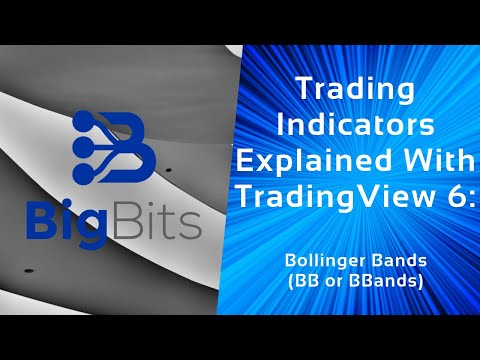YouTube Video
YouTube Video Transcript
hey this is David for big bits and in this video we’re gonna take a look at the Bollinger Band indicator and this indicator is found on trading view as a default indicator so I’ll go ahead and show you how we can add it to the chart and just kind of show you what it looks like to begin with first all you have to do is click to search for your indicators and search for Hollinger or you can probably just type in bands but you’re going to see several built-in ones based off of the Bollinger Bands but if you just want to work with the basic Bollinger Bands indicator it’s the one without any extra wording on it so let’s go ahead and click on that to add it to our chart you can see this is the Bollinger Bands indicator on our chart on trading view now there are three lines that you will notice and there is a nice color fill between these lines and what these lines represent we’re gonna get into this a little bit more in just a moment but essentially you have a middle band an upper band and a lower band and the middle band is just a moving average that we’re working with that helps to help us find what trend were working with and if you haven’t seen the moving average videos that we’ve done in this series I suggest you go back and take a look at those if you’re curious as to what I mean by a moving average now the upper band and the lower band are determined by a standard deviation for the price over this period and I’ll explain this all in just a bit but we’re also going to go over how this indicator is used in trading and a little bit more information about all of this so what I’m gonna do is I’m actually going to go ahead and show you how this is calculated and we’ll go over all of the other information because in this series what we’re doing is we’re talking about understanding the math behind the indicators so that not only do you understand what you’re looking at and how people tell you to interpret it but you can also understand how this is actually happening and why the indicator moves like it does and that can also help you with trying to interpret and predict trends that you might see so you’ll see common price action and you’ll be able to better guess what you think the indicator might do which might help you predict a better target for taking profit or entry on position so I’m going to go ahead and hide the built in indicate and I’m gonna show you the one that I had made now this is the exact same thing but I don’t have the fill between them and I have different color lines but the lines are all the same and I’ll show you this okay I have the built in one that we were looking at a moment ago overlaid with the one that I’m working with to show you what we’re doing so I’m gonna pull up the script code and this is a pine script code that tradingview users to allow you to create your own custom scripts and if you’re curious on how to do that I do have a tutorial series on that so you can check out the channel you can see I have a whole tutorial series with many videos on how to do just this but I’m going to show you how the math works here let’s actually go ahead and comment all this code out so it doesn’t work and we’ll come back and we’ll actually turn these on one at a time so the first thing we’re looking at here is this middle band so the white band on the chart I often refer to this as the mid band in the Bollinger Bands and what it is is just a moving average over the last 20 periods now you can change what type of moving average what type of data it uses to calculate and how far back that moving average goes but by default on tradingview it uses the simple moving average this SMA function on other different charting sites it may use exponential moving averages or another built-in one but the default setting is a 20 period simple moving average based on the closing price of the candles now I’m going to save this and it should just show our white line and this is our 20 period SMA that we’re working with you can kind of use the SMA to try and determine what the trend is currently so when it’s moving up you would assume that the trend is going up and when it’s moving down that the trend is moving down so what we’re going to do to determine the upper and bottom bands is we are going to calculate the standard deviation in the price over the last 20 periods so with the standard deviation we’re going to use the same period 20 that we use with calculating a simple moving average so I’m actually going to show you the standard deviation value and to do this I have to turn the overlay on the false and it’ll add a new indicator to our chart when I add it to the chart this time okay so this is the standard deviation and you can tell that when price is relatively not volatile I should say it’s not super volatile you can see that the standard deviation is much smaller because the prices in that range of that series are much closer together whereas when the price starts moving and much larger amounts the volatility increases so your standard deviation increases as well now let’s go ahead and go back to the code and what we’re going to do is we’re going to apply the standard deviation with a multiplier on top of our original moving average to calculate the upper and lower bands this is much simpler than it actually sounds I’m going to actually remove this one from the chart as well let’s put our script back to overlays true and let’s take that plot off of there so we’re no longer no longer seeing our standard deviation but we are still calculating it and storing it inside of the variable that we’re working with now that we have that what we’re going to be doing is working with a multiplier now this multiplier is what we multiply the standard deviation to to give it its distance from the mid Bollinger Band so this is the default Bollinger Band again if the standard deviation was within this range and our multiplier was two then you can tell that our standard deviation was somewhere in here and we multiplied that distance by two to create the upper band now I’m going to actually show you this in the code this is really simple stuff here so that’s exactly how the calculation works for the upper band we’re going to take our mid band calculation that white line and then we’re going to add on top of it our standard deviation times that multiplier and then for the lower band we’re gonna do the exact opposite but still the same idea we’re gonna take the mid band and subtract that standard deviation times its multiplier now once we plot all of this we should have the exact same lines that the built-in indicator has and did I not add that to the chart I’m sorry about that let’s add that to the chart so we should have the exact same lines that the built-in indicator has now yes so there we go we have the exact same lines that the indicator has we can see based on the mid line where the moving average is headed with a trend and then we can see the relatively high prices with the upper band and the relatively low prices with a lower band so this kind of goes over the math and it kind of gives you an idea of what to expect when we have these large price movements and why the Bollinger Bands move like they do that is because with more volatility the standard deviation of the same period increases and with that multiplier it moves very quickly and the bands get wider much faster when there’s more volatility now as to what the Bollinger Band is all about this was an indicator that was created by John Bollinger and I’m not gonna try and read all of this for you we’ve already went over some of this such as the calculation but if you’re not familiar with John Bollinger he actually is pretty active on Twitter he has a lot of posts he talks about crypto currencies which we talk about on this channel quite a bit as well he accepts those as donations it looks like yes his home website as well and he often talks about his indicator as well on Twitter so if you’re interested in keeping up with this indicator you can check that out he posts pretty frequently on actually now we’ve also talked about the calculation we’ve talked about volatility and I wanted to go over this just one more time the Bollinger Bands we’ve already talked about all three lines but they default that you might see elsewhere is an exponential moving average but we use the simple moving average because that’s what’s default in tradingview and we wanted to match what they had now if you want to change it all you really have to do is pull up the script code that you’re working with and change the SMA function to an EMA function and that’s all there is to change it to your different exponential moving average now the default built in when does not give you this option to change because your only options are you look back period your source standard deviation and offset so you can’t change they built in moving average type that it uses so if you want to use something different you’ll have to find another existing indicator that allows you to or you’ll have to do like we did here and create your own okay so back to this we’ve already talked about why the bands expand and that’s because there is more volatility and this is exactly what it says here and when there’s less volatility the bands get tighter now as long as the prices do not move out of the channel you can be reasonably confident that prices are moving as expected and as well as you could expect that would assume now when prices continually touch the upper Bollinger Band they are considered to be overbought and when they continually touch the lower band they’re consider to be oversold and you can use these as a signal to buy and sell however I will point out though if you look at the chart and for example what they’ve shown you here if you were to say you know it’s continually touching the bottom and I should buy you mean you could have bought back here after it touched it five or six times and it actually continued touching it to the bottom of this trend here you know 30 or 40 times so you have to be very careful about basing everything on the relative level of being overbought or oversold compared to the Bollinger Band in my opinion and in my experience I have bet better expense access using the Bollinger Bands in relation with other indicators as an excellent pair to work together now that doesn’t mean you can’t use the Bollinger Bands by themselves and I’m not giving you financial advice to do this any certain way I’m just kind of explaining to you what I’ve seen in the past and what might be an issue if you’re basing this off of this article that we’re reading where it’s saying that where it rides up these bands or rides down the bands that it signals a buy or sell well you could have signal to buy at any point there and that wouldn’t have done you any good now what is really more important is actually catching the trend changes and we can actually look at that by determining where the price deflects off of these bands so for example when the price deflects off of the lower band and then it crosses above the mid band then it’s likely that an upward trend is about to start so for example here the price bounced off of the Bollinger Band on the lower side let me zoom up well that zoom doesn’t work very well let’s see if I can zoom better like this so you see the price bounces off the lower Bollinger Band crosses the mid band and continues up and in this case a good target according to the article would have been the upper band so if you would have bought when it had bounced off the band crossed over the mid band you could have sold at the upper band according to how this article operates now the same thing can be said for looking for when to sell if you want to try and catch these periods where you’re riding the Bollinger Bands and this example it’s going down but if you want to catch it where it’s riding up you could wait for it to come back down below the mid band to sell as that would as this article indicates that would suggest that the trend would be reversing downward let me zoom back out now the bottom line this is their kind of summary here every strategy has its drawbacks Bollinger Bands are in fact one of the most commonly used indicators I see them on a lot of traders charts they are on mine by default like I mentioned for myself I don’t use them all of the time but what I do is I look to see patterns in the Bollinger Bands and for me to determine whether something’s overbought or oversold I need to compare it with another indicator as well personally I like to use the RSI which there’s another video about that indicator in this series if you go back and look at the playlist here now when the RSI is oversold and the price has been touching the bottom Bollinger Band that’s when I get a little bit more confident that the prices are actually oversold and it might be a good time to buy now that pretty much does it for this indicator there’s plenty of resources on this out there if you want to google it now the links that I’ve shown you here are going to be in the description of the video so if you want to go look at these resources for yourself you can now I’m not going to publish this script on tradingview because there’s tons of Bollinger Band indicators out there already and like I mentioned there’s already the built in one so if you need one just search the tradingview library of indicators and you’ll find plenty of Bollinger Band indicators that you can use for yourself now there is another resource that we didn’t really talk about and that is the standard deviation we kind of already mentioned how this works but you can get a much better idea of how it actually is calculated if you go here essentially the more volatility the higher the standard deviation okay and that’s what’s really important to take out of this now if you’re interested in trading view and you’ve been following this series or any other please go check out my profile on trading view you can see all kinds of scripts and other things that we’ve done on this particular channel and also please check out in the description of the video there’s also a referral that will allow you and myself to get thirty dollars towards your upgraded plan on trading view and if you do this that will really help me out but like I mentioned you could also get your own own thirty dollars toward your own upgraded plan as well but that is all for this video I hope you enjoyed the Bollinger Bands indicator explained and I hope you stick around for more or check out the other videos that we do about pond script on the channel but other than that thank you and have a nice day [Music] [Music] [Music]
YouTube Video Description
< br/> ???? IMPORTANT LINKS BELOW ????
? Sign up for a paid plan at TradingView and receive a $30 credit: https://www.tradingview.com/gopro/?share_your_love=BigBitsIO
??????????
Relative URLs:
??????????
? https://www.investopedia.com/articles/technical/102201.asp
? https://www.investopedia.com/terms/s/standarddeviation.asp
? https://twitter.com/bbands
??♂️??♂️??♂️??♂️??♂️??♂️??♂️??♂️??♂️??♂️
Social and other public profiles
??♂️??♂️??♂️??♂️??♂️??♂️??♂️??♂️??♂️??♂️
? Website: https://bigbits.io
? Discord: https://discord.gg/rapMn4z
? Twitter: https://twitter.com/BigBitsIO
? Facebook: https://www.facebook.com/BigBitsIO/
??GitHub: https://github.com/BigBitsIO
?TradingView: https://www.tradingview.com/u/BigBitsIO
???????????
Referral links
???????????
? Buy, Sell and Trade Crypto on Binance.US with LOW fees: https://www.binance.us/?ref=35105151
?♂️ Want to buy crypto? Get $10 of bitcoin w/ your first purchase over $100: https://www.coinbase.com/join/johnso_dxz
? Sign up for a paid plan at TradingView and receive a $30 credit: https://www.tradingview.com/gopro/?share_your_love=BigBitsIO
? Browse privately and get rewarded with Brave Browser: https://brave.com/big406
? Receive bonus perks when purchasing Lightnite Game: https://lightnite.io/ref=BigBits
VIEW ALL HERE: https://bigbits.io/bigbits-referrals/
❗️❗️❗️❗️❗️❗️❗️❗️❗️❗️❗️❗️❗️❗️❗️❗️❗️❗️❗️❗️❗️❗️❗️❗️❗️❗️❗️❗️❗️❗️❗️❗️❗️
DISCLAIMER: All my videos are for educational and entertainment purposes only. Nothing in this or any of my videos should be interpreted as financial advice or a recommendation to buy or sell any sort of security or investment including all types of crypto coins and tokens. Consult with a professional financial advisor before making any financial decisions. Investing in general and particularly with crypto trading especially is risky and has the potential for one to lose most or all of the initial investment. In simple terms, you are responsible for your actions when trading.
❗️❗️❗️❗️❗️❗️❗️❗️❗️❗️❗️❗️❗️❗️❗️❗️❗️❗️❗️❗️❗️❗️❗️❗️❗️❗️❗️❗️❗️❗️❗️❗️❗️
#bitcoin #crypto #cryptocurrencies #tradingview #binance #binanceUS #coinbase
This channel focuses on Bitcoin, Ethereum, LiteCoin, Ripple, Link, Basic Attention Token and almost all cryptocurrencies that demand attention. Please like the video if you liked the video, and subscribe if you like these types of videos. David from BigBits is an experienced Software Engineer, but no one is perfect, If you find any issues with any of the open-source, free code, or code shown in videos please comment to let us know what to fix, we listen to our viewers!



